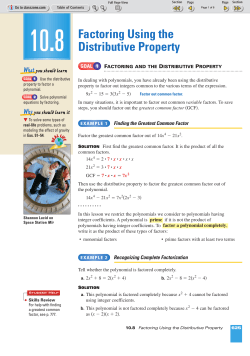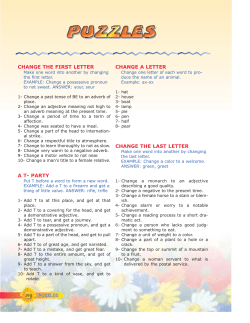
B The Distributive Property in Reverse c
CHAPTER 6 B You will need The Distributive Property in Reverse • a calculator c GOAL Factor and simplify expressions using the distributive property in reverse. Learn about the Math Arithmetic expressions can often be evaluated or simplified in multiple ways. The distributive property makes it possible to write the product of one number and the sum or difference of 2 numbers as the sum or difference of two products. Using the distributive property in reverse allows the sum or difference of two products to be written as a product of one number and the sum or difference of two numbers. Because the number and the sum or difference are factors of the resulting product, using the distributive property in this way is called factoring. Tom and Maggie are helping to plan the school carnival. They each bought four prizes for the carnival games. Tom spent $6.50 on each of his prizes, while Maggie spent $5.50 on each of the prizes she purchased. To find the total amount spent on prizes, Tom wrote down the following expression on a sheet of paper: 4 3 $6.50 1 4 3 $5.50. Maggie’s math class has been learning how to factor, and she noticed that Tom could use factoring to help him simplify this expression. factoring writing an expression as a product can Tom use factoring to simplify the following ? How expression: 4 3 $6.50 1 4 3 $5.50? A. Remember the distributive property states that for all numbers a, b, and c, a(b 1 c) 5 a 3 b 1 a 3 c. If this is true, then we know that the opposite must also be true. Complete the following statement, using the distributive property in reverse: a 3 b 1 a 3 c 5 ? B. Fill in the numbers from the problem for the variables in this expression: a 3 b 1 a 3 c. Copyright © 2009 by Nelson Education Ltd. Reproduction permitted for classrooms 6B The Distributive Property in Reverse 1 C. Now, rewrite the expression in this form: a(b 1 c), filling in the numbers from the problem for each variable. D. Perform the addition inside the brackets, followed by multiplication, to determine the total spent. You have just simplified Tom’s expression, using the distributive property in reverse. Reflecting 1. The distributive property in reverse with addition states that for all numbers a, b, and c, a 3 b 1 a 3 c 5 ? 2. Write the statement for the distributive property in reverse with subtraction. 3. When might you choose to factor an expression using the distributive property in reverse? Work with the Math Example 1: Using the distributive property in reverse with addition Use the distributive property in reverse to evaluate the expression 8 3 2 1 8 3 9. Kurt’s Solution: 8321839 2 This expression is in the same form as a 3 b 1 a 3 c. Since 8 is a factor in each term of the sum, I realize that it can be factored using the distributive property in reverse. 5 8(2 1 9) According to the distributive property, I can factor out the 8 and rewrite the expression in the form a(b 1 c), where a 5 8, b 5 2, and c 5 9. 5 8(11) 5 88 Now I simplify the expression inside the brackets and then multiply. Nelson Mathematics Elementary Year Two, Cycle One Reproduction permitted for classrooms Copyright © 2009 by Nelson Education Ltd. Example 2: Using the distributive property in reverse with subtraction Use the distributive property in reverse to simplify the expression 6 3 4 2 6 3 2. Chandra’s Solution: 6342632 A This expression is in the same form as a 3 b 2 a 3 c. Since 6 is a factor in each term of the difference, I realize that it can be factored using the distributive property in reverse. 5 6(4 2 2) According to the distributive property, I can factor out the 6 and rewrite the expression in the form a(b 2 c), where a 5 6, b 5 4, and c 5 2. 5 6(2) 5 12 Now I simplify the expression inside the brackets and then multiply. Checking 4. Use the distributive property in reverse to simplify the following expression: 26 3 4 1 3 3 26. 5. Use the distributive property in reverse to factor the following expression: 7 3 8 2 8 3 5. B Practising 6. Identify if the distributive property in reverse was used on each of the following equations. 3 3 8 1 3 3 3 5 3 (8 1 3) 7 2 4 3 7 2 2 5 7 (4 2 2) 9 3 4 1 3 3 5 5 9 (4 1 5) 22 3 4 1 7 3 (22) 5 22 (4 1 7) e) 3 3 (25) 2 2 3 (25) 5 25 (3 2 2) a) b) c) d) Copyright © 2009 by Nelson Education Ltd. Reproduction permitted for classrooms 7. Factor each expression, using the distributive property in reverse. a) b) c) d) e) f) g) h) i) j) k) l) m) n) o) p) 4361433 2382234 (22) 3 7 1 (22) 3 6 8352832 (27) 3 4 2 (27) 3 3 9 3 (24) 1 9 3 3 6341632 7382237 6352533 10 3 3 2 10 3 2 22 3 11 1 22 3 9 42 3 3 1 42 3 2 36 3 3 2 1 3 36 30 3 8 1 30 3 9 65 3 40 1 10 3 65 2 3 21 1 21 3 8 6B The Distributive Property in Reverse 3 8. Factor each expression, using the distributive property in reverse. Then evaluate. a) b) c) d) e) f) g) h) i) j) k) l) m) n) o) p) 7321739 2361237 4332734 6352632 9361339 10 3 9 2 10 3 4 15 3 2 1 15 3 3 32 3 10 2 32 3 9 9371239 81 3 11 2 81 3 4 44 3 8 2 6 3 44 4351533 14 3 2 1 14 3 6 61 3 2 1 4 3 61 12 3 8 2 8 3 3 25 3 6 1 25 3 7 Nelson Mathematics Elementary Year Two, Cycle One Extending 10. Factor each expression, using the distributive property in reverse. Then evaluate. a) b) c) d) e) 93619341932 11 3 8 2 11 3 5 2 11 3 1 16 3 4 1 16 3 9 2 16 3 2 80 3 10 1 8 3 80 2 80 3 9 100 3 35 2 100 3 19 2 2 3 100 11. Determine if the two expressions below have the same value. If so, state the value. If they do not, state the value of each expression. a) 4 3 6 1 5 3 4 2 4 3 2 b) 6 3 7 2 5 3 6 1 3 3 2 1 6 3 3 9. Mr. Malloy cashes a check at the bank and gets 10 of each of the following: $1 coins, $2 coins, $5 bills, $10 bills, and $50 bills. Write two expressions for the amount of money that Mr. Malloy received and then determine the amount. 4 C 12. Use the distributive property in reverse to factor the expression a3 1 ab 1 ac2 1 a2d. Reproduction permitted for classrooms Copyright © 2009 by Nelson Education Ltd.
© Copyright 2025





















